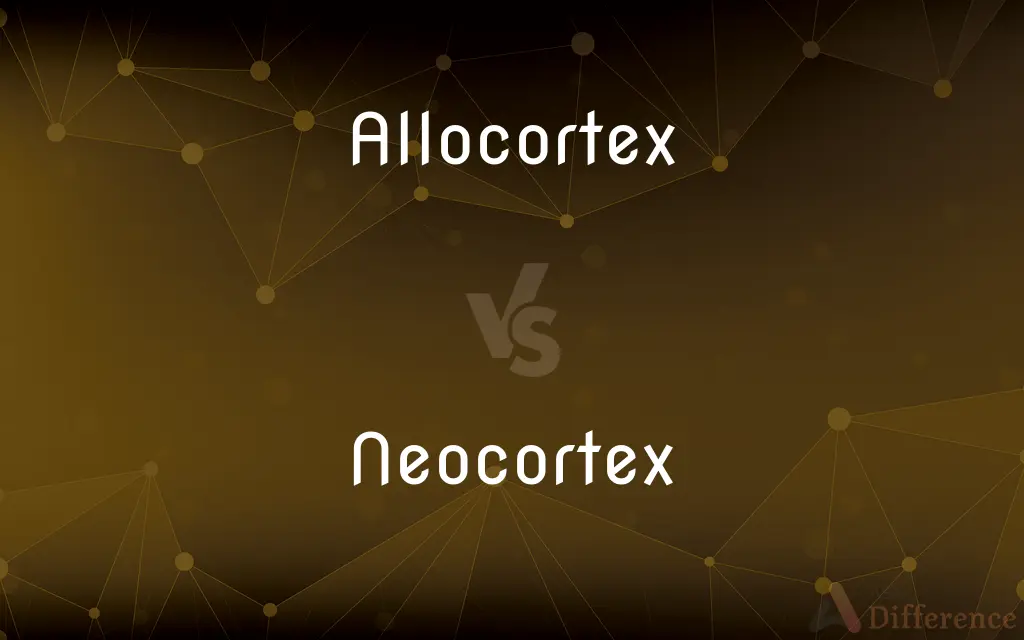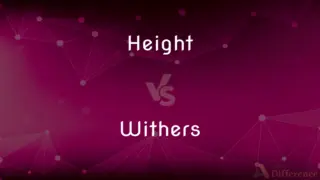Allocortex vs. Neocortex — What's the Difference?
Edited by Tayyaba Rehman — By Maham Liaqat — Updated on April 16, 2024
The allocortex has fewer layers and manages instinctive behaviors and emotions, whereas the neocortex, with six layers, handles higher cognitive functions like reasoning.

Difference Between Allocortex and Neocortex
Table of Contents
ADVERTISEMENT
Key Differences
The allocortex is characterized by having three to five layers of neurons, tailored for basic survival functions such as emotion and memory. In contrast, the neocortex, often referred to as the "newer" part of the cerebral cortex, consists of six distinct layers of neurons, which are crucial for higher-order cognitive tasks.
In terms of evolutionary development, the allocortex is considered one of the oldest parts of the brain, associated with more primitive functions. On the other hand, the neocortex is a more recent evolutionary development, significantly expanded in humans, enabling complex problem solving and sophisticated sensory perception.
The allocortex includes regions such as the hippocampus and olfactory cortex, which are pivotal for memory formation and the sense of smell, respectively. Whereas the neocortex covers a larger portion of the human brain and is involved in functions such as spatial reasoning, conscious thought, and language processing.
Functionally, the allocortex plays a critical role in controlling autonomic functions and emotional responses. Meanwhile, the neocortex is integral in processing sensory inputs and executing motor commands, showcasing its versatility and complexity.
Structurally, the simpler architecture of the allocortex supports its direct, robust responses to stimuli, essential for survival instincts. Conversely, the intricate structure of the neocortex facilitates a wide range of neural connections, supporting a vast array of complex behaviors and higher intellectual functions.
ADVERTISEMENT
Comparison Chart
Number of Layers
3-5 layers
6 layers
Functions
Emotion, memory
Reasoning, sensory perception
Evolution
Older, more primitive
Newer, more developed
Key Regions
Hippocampus, olfactory cortex
Frontal lobes, parietal lobes
Cognitive Role
Basic survival functions
Higher-order cognitive functions
Compare with Definitions
Allocortex
Directly associated with the limbic system.
The allocortex's involvement with the limbic system influences emotional responses.
Neocortex
The largest part of the human cerebral cortex that manages higher cognitive processes.
Activities like planning and decision making are functions of the neocortex.
Allocortex
Contains fewer layers of neurons than other cortical areas.
The simplified structure of the allocortex relates to its basic operational roles.
Neocortex
Contains six distinct layers of neurons.
The six-layered structure of the neocortex supports complex neural interactions.
Allocortex
Involved in olfactory processing.
Smell processing in the brain is primarily the function of the allocortex.
Neocortex
Crucial for sensory perception, conscious thought, and language.
The neocortex processes sensory information to form coherent perceptions.
Allocortex
Part of the brain's cerebral cortex, involved in primitive functions.
The allocortex is crucial for processing emotions and memory.
Neocortex
Involved in spatial reasoning and conscious thought.
The neocortex allows for the visualization of complex spatial relationships.
Allocortex
Helps regulate autonomic and endocrine functions.
The allocortex plays a role in the body's involuntary physiological responses.
Neocortex
Handles motor commands and detailed processing.
Fine motor skills are refined and controlled by the neocortex.
Allocortex
The allocortex or heterogenetic cortex, and neocortex are the two types of cerebral cortex in the brain. The allocortex is the much smaller area of cortex taking up just 10 %, the neocortex takes up the remaining 90 %.
Neocortex
The neocortex, also called the neopallium, isocortex, or the six-layered cortex, is a set of layers of the mammalian cerebral cortex involved in higher-order brain functions such as sensory perception, cognition, generation of motor commands, spatial reasoning and language. The neocortex is further subdivided into the true isocortex and the proisocortex.In the human brain, the neocortex is the largest part of the cerebral cortex, which is the outer layer of the cerebrum, with the allocortex making up the rest.
Allocortex
(anatomy) The heterogenetic cortex; part of the cerebral cortex characterized by fewer cell layers than the neocortex (i.e. fewer than six)
Neocortex
The dorsal region of the cerebral cortex, especially large in primates, thought to have evolved more recently than other parts of the brain. Also called neopallium.
Neocortex
(neuroanatomy) The top layer of the cerebral hemispheres in the brain of mammals; part of the cerebral cortex.
Neocortex
The cortical part of the neencephalon; the most recently evolved part of the cerebral cortex of the brain of higher animals, and the site of most of the higher brain functions; called also neopallium.
Neocortex
The cortical part of the neencephalon
Common Curiosities
Is the neocortex unique to humans?
While most mammals have a neocortex, its size and complexity are particularly developed in humans.
What is the role of the neocortex in visual processing?
The neocortex processes complex visual information, enabling detailed perception and recognition.
How does the allocortex affect learning and memory?
The hippocampus, part of the allocortex, is crucial for the formation and retrieval of long-term memories.
How does the structure of the allocortex contribute to its functions?
The allocortex's fewer layers facilitate rapid and direct processing of emotions and instinctive behaviors.
How does damage to the allocortex manifest in behavior?
Damage to the allocortex can result in impaired memory, diminished emotional control, and difficulties in spatial orientation.
Does the neocortex contribute to creativity?
Yes, the neocortex is involved in abstract thinking and creativity, particularly through its frontal lobes.
What specific regions make up the allocortex?
The allocortex primarily consists of the hippocampus and olfactory cortex.
What evolutionary advantage does the neocortex provide?
The neocortex allows for advanced learning, complex social interactions, and adaptability to diverse environments.
Does the neocortex have a role in motor skills?
Yes, the neocortex is crucial for planning and executing precise motor functions and coordination.
Can functions typically managed by the neocortex be found in the allocortex?
Generally, no; the allocortex does not handle complex cognitive tasks that are typical of the neocortex, like advanced problem-solving.
What impact does aging have on the neocortex?
Aging can lead to thinning of the neocortex, which may affect cognitive functions such as memory and attention.
How does the neocortex facilitate communication?
The neocortex is essential for language processing, both in understanding and producing speech.
How does the allocortex interact with other parts of the brain?
The allocortex connects with several brain regions, including those involved in the limbic system, influencing both physiological and psychological responses.
How is the allocortex involved in emotional responses?
The allocortex processes basic emotional responses and is tightly linked to the limbic system, regulating feelings like fear and pleasure.
What are the consequences of neocortical development in early childhood?
Rapid neocortical development in early childhood is critical for cognitive skills, sensory processing, and motor abilities.
Share Your Discovery

Previous Comparison
Green vs. Inexperienced
Next Comparison
Height vs. WithersAuthor Spotlight
Written by
Maham LiaqatEdited by
Tayyaba RehmanTayyaba Rehman is a distinguished writer, currently serving as a primary contributor to askdifference.com. As a researcher in semantics and etymology, Tayyaba's passion for the complexity of languages and their distinctions has found a perfect home on the platform. Tayyaba delves into the intricacies of language, distinguishing between commonly confused words and phrases, thereby providing clarity for readers worldwide.
















































